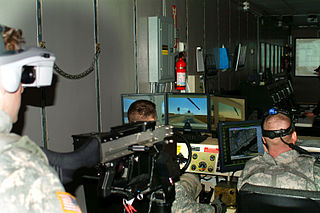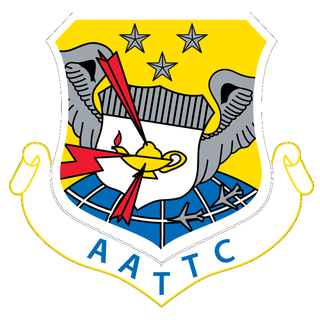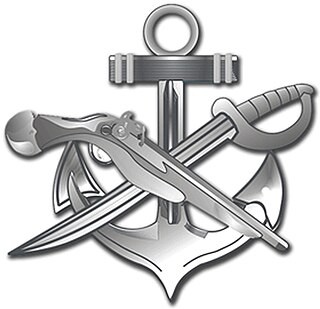The United States Armed Forces are the military forces of the United States. The armed forces consists of six service branches: the Army, Marine Corps, Navy, Air Force, Space Force, and Coast Guard. All six armed services are among the eight uniformed services of the United States.

Force Reconnaissance (FORECON) is a United States Marine Corps deep reconnaissance unit which supplies military intelligence to the command element of the Marine Air-Ground Task Force (MAGTF). Force Reconnaissance companies unlike USMC division reconnaissance report to the Marine expeditionary force (MEF) and provide direct action and deep reconnaissance during large-scale operations.

United States Navy Explosive Ordnance Disposal technicians render safe all types of ordnance, including improvised, chemical, biological, and nuclear. They perform land and underwater location, identification, render-safe, and recovery of foreign and domestic ordnance. They conduct demolition of hazardous munitions, pyrotechnics, and retrograde explosives using detonation and burning techniques. They forward deploy and fully integrate with the various Combatant Commanders, Special Operations Forces (SOF), and various warfare units within the Navy, Marine Corps, Air Force and Army. They are also called upon to support military and civilian law enforcement agencies, as well as the Secret Service.

The Naval Aviation Warfighting Development Center was formerly known as the Naval Strike and Air Warfare Center at Naval Air Station Fallon located in the city of Fallon in western Nevada. It is the center of excellence for naval aviation training and tactics development. NAWDC provides service to aircrews, squadrons and air wings throughout the United States Navy through flight training, academic instructional classes, and direct operational and intelligence support. The name was changed from NSAWC to NAWDC in June 2015 to align with the naming convention of the Navy's other Warfighting Development Centers (including Naval Surface and Mine Warfighting Development Center, Naval Information Warfighting Development Center, and the Undersea Warfighting Development Center.
SIMNET was a wide area network with vehicle simulators and displays for real-time distributed combat simulation: tanks, helicopters and airplanes in a virtual battlefield. SIMNET was developed for and used by the United States military. SIMNET development began in the mid-1980s, was fielded starting in 1987, and was used for training until successor programs came online well into the 1990s.

Naval Surface Warfare Center Crane Division is the principal tenant command located at Naval Support Activity Crane. NSA Crane is a United States Navy installation located approximately 25 miles (40 km) southwest of Bloomington, Indiana, and predominantly located in Martin County, but small parts also extend into Greene and Lawrence counties. It was originally established in 1941 under the Bureau of Ordnance as the Naval Ammunition Depot for the production, testing, and storage of ordnance under the first supplemental Defense Appropriation Act. The base is named after William M. Crane. The base is the third largest naval installation in the world by geographic area and employs approximately 3,300 people. The closest community is the small town of Crane, which lies adjacent to the northwest corner of the facility.

DARWARS was a research program at DARPA intended to accelerate the development and deployment of military training systems. These were envisioned as low-cost, mobile, web-centric, simulation-based, “lightweight” systems designed to take advantage of the ubiquitous presence of the PC and of new technology, including multi-player games, virtual worlds, off-the-shelf PC simulations, intelligent agents, and on-line communities. The project started in 2003 under the leadership of DARPA Program Manager Dr. Ralph Chatham, a former U.S. Navy officer.

The Advanced Airlift Tactics Training Center, (AATTC), is located at Rosecrans Air National Guard Base, Saint Joseph, Missouri. The host unit is the 139th Airlift Wing, Missouri Air National Guard. Founded in 1983, the AATTC was the brainchild of Major Howard W. Dixon, a pilot who sought the need to establish low level combat survival training and maneuvers for C-130 aircrews; as well as the airlift community as a whole. This evasive aerial survival training had been exclusive to the fighter community up until the establishment of the AATTC, which would expand this training to C-130 aircrews. The school would continue to evolve with the combined efforts of the technicians, AGR's and members of the 180th Airlift Squadron.

Operations Specialist is a United States Navy and United States Coast Guard occupational rating. It is a sea duty-intensive rating in the Navy while most of Coast Guard OS's are at ashore Command Centers.

The United States Army Armor School is a military training school located at Fort Moore, Georgia. Its primary focus is the training of United States Army soldiers, non-commissioned officers, warrant officers, and commissioned officers. It also trains for equipment handling, including the M1 Abrams, the Bradley Fighting Vehicle, and the Stryker Mobile Gun System. The Armor School moved to Fort Benning in 2010 as part of the United States Base Realignment and Closure program.

The Special Warfare Combat Crewmen (SWCC ) are United States Naval Special Warfare Command personnel who operate and maintain small craft for special operations missions, particularly those of U.S. Navy SEALs. Their rating is Special Warfare Boat Operator (SB).

The Operational Test and Evaluation Force (OPTEVFOR) is an independent and objective agency within the United States Navy for the operational testing and evaluation (OT&E) of naval aviation, surface warfare, submarine warfare, C4I, cryptologic, and space systems in support Navy and Department of Defense acquisition programs.
Live, Virtual, & Constructive (LVC) Simulation is a broadly used taxonomy for classifying Modeling and Simulation (M&S). However, categorizing a simulation as a live, virtual, or constructive environment is problematic since there is no clear division among these categories. The degree of human participation in a simulation is infinitely variable, as is the degree of equipment realism. The categorization of simulations also lacks a category for simulated people working real equipment.
Mounted Warfare TestBed (MWTB) at Fort Knox, Kentucky, was the premier site for distributed simulation experiments in the US Army for over 20 years. It used simulation systems, including fully manned virtual simulators and computer-generated forces, to perform experiments that examined current and future weapon systems, concepts, and tactics.
The ADMS is an emergency and disaster management training simulation system designed to train incident commanders, first responders, and incident command teams in a real-time, interactive virtual reality environment. ADMS was first introduced by Environmental Tectonics Corporation (ETCC:US) in 1992. The development of ADMS was in response to the crash of British Airtours Flight 28M at the Manchester airport in 1985, in which 55 people died. Following the accident research indicated that first responder training should include realistic scenarios. The first ADMS system was produced for the UK Ministry of Defence, and delivered to Royal Air Force's (RAF) Manston Facility. Since its inception, ADMS has evolved into a modular, expandable disaster simulation platform, with systems in use worldwide.
Forward observers in the U.S. military are artillery observers who carry the Military Occupational Specialty designator of 13F in the United States Army and 0861 in the United States Marine Corps. They are officially called Joint Fire Support Specialists in the U.S. Army and Fire Support Marines in the U.S. Marine Corps. They are colloquially known as FiSTers, regardless of whether they are members of a FiST. The Battalion Fire Support Officer (FSO) is the Officer in Charge of a Battalion Fire Support Element.
Mission Command Training Program, based at Fort Leavenworth, Kansas, is the U.S. Army's only worldwide deployable Combat Training Center. MCTP provides full spectrum operations training support for senior commanders and their staffs so they can be successful in any mission in any operational environment. Its Senior Mentors counsel and offer their experience to Army senior commanders, subordinate commanders and staff. Additionally, MCTP's professional observer-trainers assist units with objective feedback and suggestions for improvement.
The Joint Theater Level Simulation (JTLS) is used to simulate joint, combined, and coalition civil-military operations at the operational level. Used for civil/military simulations and humanitarian assistance/disaster relief (HA/DR) scenarios, JTLS is an interactive, computer-assisted simulation that models multi-sided air, ground, and naval resources with logistical Special Operation Forces (SOF) and intelligence support. The primary purpose of JTLS is to create a realistic environment in which agency staff can operate as they would within a real-world or operational situation. A training audience conducts a scenario or event to practice their ability to coordinate various staff functions.

The Improved Performance Research Integration Tool (IMPRINT) is a discrete-event simulation and human performance modeling software tool developed by the Army Research Laboratory and Micro Analysis and Design. It is developed using the .NET Framework. IMPRINT allows users to create discrete-event simulations as visual task networks with logic defined using the C# programming language. IMPRINT is primarily used by the United States Department of Defense to simulate the cognitive workload of its personnel when interacting with new and existing technology to determine manpower requirements and evaluate human performance.
FAAC Incorporated is an American immersive simulation training company. They began as a military contractor, providing flight and weapons simulation systems to the U.S. Air Force, but have since branched out into transit and transportation simulation, law enforcement, Fire/EMS, research, and human-interaction simulation.











